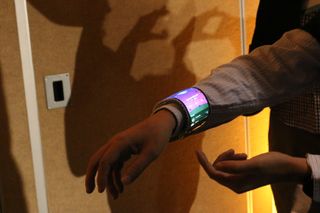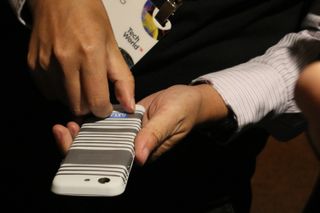Up Close with Lenovo's Bendable Smartphone
During its Lenovo World keynote, the device maker showed off a pair of bendable devices: a phone bracelet and a tablet that bends in half.
We've been hearing about flexible screens for years now, but most of the demonstrations were theoretical prototypes, not fully functioning products. During its Lenovo Tech World keynote, Lenovo executives showed off a real, working bendable phone bracelet and foldable tablet. Later on, we got to see demos of both devices up close, and while both products impressed us, it'll be a while before you're bending either one to your will.

During a speech about his company's innovations, Lenovo senior vice president and chief technology officer Peter Hortensius said that the company had designed devices with internal components that bend along with their displays.
"A flexible screen doesn't help without another set of parts," he said.
Hortensius asked YouTube celebrity Meghan McCarthy, who was seated in the audience, to show off some gadgets the company had lent her. She then took out a Android phone that Lenovo has dubbed the CPlus and bent it so that it snapped around her wrist.

McCarthy also pulled out a 9- to 10-inch tablet, which Lenovo has dubbed the Folio. She was able to fold it in half so that it was about the size of a large phone. She held the folded slate to her ear and pretended to make a call.
The demos are every bit as impressive up close, as we learned during a briefing later during the day. A Lenovo executive bent the CPlus over his wrist — in a clever touch the graphics on the phone's display simulated cracking glass. But the phone was just fine, with a display you could easily read just with a glance at your wrist.

That's significant, Hortensius pointed out, as many of the foldable display demos we've seen up to this point feature screens that bend in. "That's nice for the display, but not nice for the end user which is what we think matters," Hortensius said. Instead, Lenovo worked on making the OLED display bend out, which lets you see and interact with the information on your screen.

The back of the CPlus prototype has a number of different hinges, which look like silver stripes on the back of the device.
As for the Folio tablet, when it's fully extended there's a noticeable peak in the middle of the display where the device folds. As the Lenovo executive folded the screen like a book, the hinge itself became a curved screen not unlike what you'd find on the Galaxy S7 Edge, while half of the main screen functioned like a smartphone.
The trick here, Hortensius said, is not only to get a device with components that can bend along with the display, but also make a device that's able to hold its shape so that the folded-up tablet remains folded. From what we saw during our Tech World demo, it's a feat Lenovo managed to pull off.
Sign up to get the BEST of Tom’s Guide direct to your inbox.
Upgrade your life with a daily dose of the biggest tech news, lifestyle hacks and our curated analysis. Be the first to know about cutting-edge gadgets and the hottest deals.

But it's still a prototype at this stage. Hortensius says the bendable devices simply aren't durable enough to survive in the wild, and during our demo, when one of us reached out to touch the Folio tablet, a Lenovo executive pulled it away with admirable dexterity. While we didn't a chance to touch either the CPlus or the Folio — let alone try them out ourselves — they certainly looked fragile enough to not be ready for the kind of repeated daily use a consumer would put either product through.
Hortensius declined to say how far off it was before something like the CPlus or Folio would be ready for everyday use, but when pressed, said it would be within five years. "Sooner than that," he said when a reporter asked if the bendable devices were five years away from being commercially viable products.
Lenovo's demo comes just a few days after reports surfaced that Samsung was working on a bendable phone, with Bloomberg suggesting the phones could be ready by the next Mobile World Congress in February 2017.
